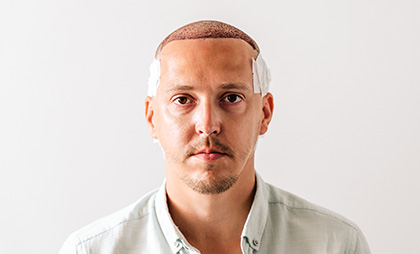What Is DHI Hair Transplant
Hair loss is a prevalent issue affecting a significant portion of the population, with over 85% of men experiencing it by the age of 50, compared to 50% of women. Over the past few years, numerous solutions and techniques have been developed to address this concern, with one of the latest and most effective methods being the Direct Hair Implantation (DHI) technique.
During a hair transplant surgery, hair follicles are moved from a healthy donor area to the balding regions. The process involves extracting follicles from the back of the head, known as the donor area, and implanting them into the areas experiencing hair loss, where they will eventually grow new hair.
DHI, an advancement over the Follicular Unit Extraction (FUE) technique, follows a similar process but with notable differences. Unlike FUE, where the doctor first creates hair channels and then implants individual follicles, DHI involves opening the channels and simultaneously implanting the hair follicles.



DHI Techniques
During the Direct Hair Implantation (DHI) procedure, hair follicles are extracted from the donor area and immediately implanted into the recipient area using the Choi Implanter Pen. The process typically lasts between 6 to 8 hours and can involve implanting up to 3500 follicles.
There are two primary techniques in the DHI method, chosen based on the patient’s needs:
- Mega DHI Technique: This approach allows for the transplantation of up to 7000 hair follicles, conducted across two sessions on consecutive days. It aims to achieve higher density.
- Extremely DHI Technique: Similar steps are followed in the Extremely DHI technique, but it permits the transplantation of up to 5000 hair follicles in a single session lasting 12-15 hours.
Candidates For DHI Hair Transplant
The DHI technique for hair transplantation is usually required in some instances as it is unsuitable for everyone. Men and women with androgenic alopecia areata, commonly called male or female pattern hair loss, are generally the best candidates for DHI hair transplantation.
To be a suitable candidate for hair transplantation with the DHI technique, here are the required characteristics:
- Age: The candidate should be over 25 years old; hair loss can be more unpredictable before this age.
- General Health: The candidate must be in good health.
- Hair density: The patient’s donor area should have enough follicles per square centimeter to suit the hair transplant.
- Hair diameter: Generally, people with thicker hair achieve better results than those with thinner hair.
Preparation for a DHI hair transplant is crucial for ensuring optimal results and minimizing potential risks. Here are important guidelines that patients must adhere to:
- Avoid consuming alcohol for at least one week prior to the procedure, as it can diminish the effectiveness of anesthesia.
- Cease smoking for a minimum of two weeks before the scheduled transplant to promote better healing and circulation.
- Refrain from consuming blood-thinning substances, including natural beverages like green tea.
- Discontinue the use of pain-relieving medications such as aspirin and ibuprofen prior to the procedure.
- Maintain a nutritious and well-balanced diet leading up to the DHI hair transplant to support overall health and reduce the likelihood of complications during and after the surgery.


Stages of DHI Hair Transplantation:
Initial stage: At this point, we assess the density of the donor area, the extent of baldness, and determine the number of follicles to be extracted. Subsequently, a skilled professional designs a new natural hairline.
Second phase: The patient undergoes essential tests and examinations, including blood tests and dermatological assessments.
Third step: In the DHI technique, the donor area is shaved to facilitate the extraction of grafts. Local anesthesia is administered to ensure a comfortable procedure for the patient.
Fourth step: Here, the doctor begins extracting hair follicles from the donor area using a Micro Motor. The harvested grafts are then immersed in a saline solution known as Hypothermosol to preserve their viability while outside the scalp.
Fifth and final stage: Hair transplantation occurs. With the DHI method, hair follicles are placed into Choi pens, which create channels and simultaneously implant the grafts with just one click.
Following the DHI hair transplant procedure, proper post-operative care is crucial for achieving optimal results. Here are the instructions to be followed during the hair restoration period:
- Maintain an upright head position and minimize bending for the initial three days to prevent swelling around the forehead and eyes.
- Wear a headband for 48 hours to reduce the risk of swelling.
- Avoid washing your hair for three days following the procedure.
- Refrain from swimming in the sea for three months and in pools for two months to safeguard the newly implanted follicles.
- Minimize exposure to direct sunlight, heat, rain, dust, and high humidity for at least a month. Consider wearing a medical hat when venturing outdoors.
- Refrain from smoking for at least two months post-procedure, as it can impede follicle growth and lead to premature shedding.
- Use only medical shampoo for washing your hair; avoid chemical shampoos.
- Avoid Turkish baths, steam baths, or saunas for at least a month, as they can adversely affect follicle health.
- Adhere to prescribed treatments and medications provided by your doctor to facilitate wound healing and enhance follicle growth.
- Abstain from sexual activity for one week post-procedure.
- Once comfortable, you may gradually resume work and daily activities.
Here are some rephrased recommendations for individuals considering a hair transplant procedure:
- PRP needles are advisable for reinforcing the transplanted follicles, while cold laser sessions can aid in stimulating blood flow for hair restoration and fortifying the implanted hair follicles.
- Incorporating hair vitamins post-transplantation can promote hair growth and overall hair health.
- Typically, visible hair follicle growth can be observed around six months post-procedure, with full results becoming apparent within a year.
- When opting for a hair transplant, it’s crucial to meticulously select a reputable clinic. While the procedure may seem straightforward, opting for unqualified professionals or subpar materials could yield undesirable outcomes.
- Prior to committing to a clinic, scrutinize their before-and-after images to gauge their expertise. Additionally, inquire about the comprehensive costs and what services are encompassed to ensure optimal value for your investment.



